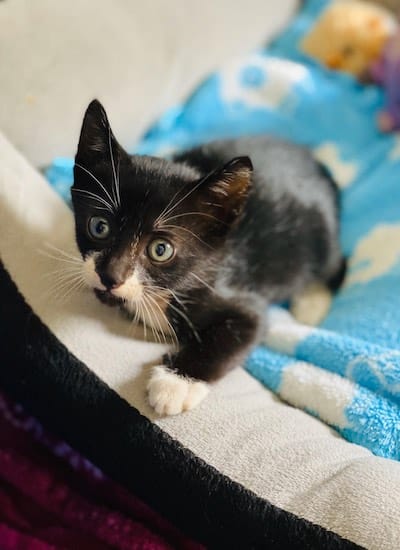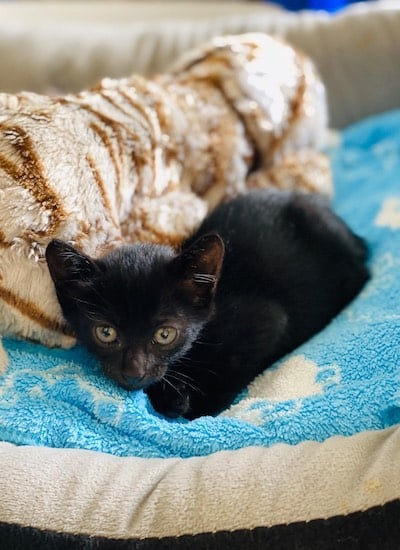Why Can’t We Be (Feline) Friends? How To Introduce Your New Cat to Your Resident Cat
PUBLISHED March 5th, 2020 05:00 am | UPDATED May 18th, 2020 05:15 pm
If you love cats, you’ve probably dreamed of owning more than one. And it’s a good thing: Most cats are social creatures, and while perfectly capable of being left alone, they do get lonely and will likely thrive better with a feline companion to play with. This is especially if they are usually left alone when everyone in the household leaves for work. So if you’re been thinking of having more than one feline in the household, Project LUNI has some useful tips to help ease you into the process of introducing your resident to a new adoptee.

Before you get carried away with thoughts of happy playtime (it doesn’t help that Instagram is flooded with coo-inducing images of cats snuggled together sleeping), here’s a reality check. There is typically a period of socialising where the resident feline and the new one get used to each other. Every situation is different, so it could take days, weeks or even months. In some households, it even triggers what seems like an all-out war where hissing, growling and fighting may occur.
Some owners say the cats will work it out themselves, but don’t take that for granted. It’s a risk you take and it may cause huge anxiety in the household for a while. Instead, follow these steps to increase your chances of a smooth integration, keeping the peace and a harmonious home!
KITTEN VS ADULT CAT
The chances of an adult cat getting along with a new feline in the household increases if it’s a kitten, versus another adult cat. If you’re thinking of bringing in a kitten, it is usually better to take in a pair so they can play with each other, while your older cat gets comfortable with the idea.
Personality also matters. If your resident feline is mellow and laid back, it may be intimidated by one with boundless energy or is more aggressive. Try to match the personalities as that may reduce some of the tension when they first meet.
PREPARING YOUR HOME
 Setting up a base camp as a safe space for your new feline is key, as cats are territorial creatures and your resident feline is likely to see the new one as a threat to its space, attention from its owner and even food. Expect a lot of hissing and growling from your feline or through the closed door from both cats; it’s normal and a natural way for them to express themselves through this transition period.
Setting up a base camp as a safe space for your new feline is key, as cats are territorial creatures and your resident feline is likely to see the new one as a threat to its space, attention from its owner and even food. Expect a lot of hissing and growling from your feline or through the closed door from both cats; it’s normal and a natural way for them to express themselves through this transition period.
Keep the door closed for a while as you go about your normal feeding routine. This time, try to feed both at the same time – with the closed door as a visual and physical barrier – so that they associate the pleasure of eating with each other’s company. This routine is important for both felines so you can set the stage for them to get used to a ritual of mealtimes together.
Try to also familiarise each feline with the other’s scent. It could be a towel or old t-shirt that you rub on one to let the other sniff. Do this periodically so they begin to accept that this scent is part of the space they inhabit. It also helps if there’s enough space in your household to let each feline explore the other’s space without letting them see each other, allowing the household to take on a shared scent.
After a few days, you may start to let them get a glimpse of each other through a gate, or opening the door just a bit. How soon you do this depends on how your resident feline is acclimatising. If it’s still extremely hostile and refuses to go near the door, give it a few more days.
THE FIRST MEETING
When you think both are ready to meet and mingle for the first time, carefully let them do so under your close supervision. Again, expect some hissing and growling as they size the other up and establish the pecking order. They may get along quickly, and they may not, but it is important to engage them and not leave them to it. It would be a great help if someone can be with you, so that you can engage both cats at the same time but separately even as they keep an eye out for the other. Play with one, then the other, and back again, in the same space, to distract them from a staredown or Mexican stand off. Intervene if a physical fight breaks out, or praise them profusely if they seem to be tolerating each other’s presence. Repeat this process for as long as necessary.
KEEP UP THE RHYTHM
 What you’re trying to do is establish a positive association as soon as the cats see each other, either through play, praise or food. Keep this routine up – ideally with someone to help you each time – until they seem at peace having the other in the near vicinity. Start feeding both in sight of each other.
What you’re trying to do is establish a positive association as soon as the cats see each other, either through play, praise or food. Keep this routine up – ideally with someone to help you each time – until they seem at peace having the other in the near vicinity. Start feeding both in sight of each other.
Once you remove the physical barrier, make sure that they still have their own spaces to go to when they need some alone time. Boxes, shelves, high chairs, cat trees and cat tunnels help. Make sure that they also know where their respective litter boxes are, and keep them in separate areas of the house. The general rule of thumb is one litter box for each cat, and one extra; i.e. If you have 2 cats, have 3 litter boxes. This is to prevent the new one from using the resident feline’s litter box, which will likely trigger anxiety in the resident feline as an invasion of its territory.
Continue to look out for your felines even as they are in each other’s company without barriers. After a while, you can do away with the praise and treats as they – and you – settle into normalcy.
Don’t be discouraged if your felines are taking a while to get used to each other. It can take several tries, and they may sometimes even ‘regress’, so start the process again where you left off if they do. It’s a process that requires patience, and mostly, attention and love. We’ve seen the highest rate of success with adopters who adopt a pair of kittens into their household with an existing cat. However, even if you have an adult cat and want to adopt another adult, the above steps will definitely help you ease into the process. It’s a fulfilling journey that will reward you with a harmonious home and more cuddles to go around.
ABOUT PROJECT LUNI
Project LUNI is a Singapore-registered non-profit organization that has been saving street cats and kittens since 2017. Founded by Nina Heusler-Astolfi and Lukas Heusler, the project focuses on four pillars: Rehoming kittens, daily feeding of street cats, Trap-Neuter-Release (TNR) and medical care for street cats. Together with a passionate team of volunteers they successfully rehomed 117 cats in 2019 and have also sterilised more than 400 cats since their inception.
All of Project LUNI’s kittens and cats are vaccinated, dewormed and treated against fleas and mites if necessary. They have visited a vet for at least one full health check and will give you the vaccination booklet at the adoption date. Mostly, Project LUNI understands how important it is to socialise and shower them with love so they will make a perfect family member and are happy to live in a home before putting them up for adoption.
Check out the latest adoption posts on their Facebook and Instagram pages and in our weekly newsletter. Project LUNI also provides regular tips on how to care for your felines on their socials, so you’re welcome to drop them a message if you have any questions.

